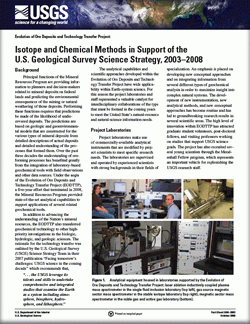
Product Details
- Product Number
- 226364
- Series
- CIR-1343
- Scale
- NO SCALE
- Alternate ID
- CIR-1343
- ISBN
- 978-1-4113-2603-3
- Authors
- ROBERT O RYE
- Version Date
- 01/01/2010
- Countries
- USA
- Media
- Paper
- Format
- Bound
Additional Details
- Description
- Principal functions of the U.S. Geological Survey (USGS) Mineral Resources Program are providing assessments of the location, quantity, and quality of undiscovered mineral deposits, and predicting the environmental impacts of exploration and mine development. The mineral and environmental assessments of domestic deposits are used by planners and decisionmakers to improve the stewardship of public lands and public resources. Assessments of undiscovered mineral deposits on a global scale reveal the potential availability of minerals to the United States and other countries that manufacture goods imported to the United States. These resources are of fundamental relevance to national and international economic and security policy in our globalized world economy. Performing mineral and environmental assessments requires that predictions be made of the likelihood of undiscovered deposits. The predictions are based on geologic and geoenvironmental models that are constructed for the diverse types of mineral deposits from detailed descriptions of actual deposits and detailed understanding of the processes that formed them. Over the past three decades the understanding of ore-forming processes has benefited greatly from the integration of laboratory-based geochemical tools with field observations and other data sources. Under the aegis of the Evolution of Ore Deposits and Technology Transfer Project (referred to hereinafter as the Project), a 5-year effort that terminated in 2008, the Mineral Resources Program provided state-of-the-art analytical capabilities to support applications of several related geochemical tools to ore-deposit-related studies. The analytical capabilities and scientific approaches developed within the Project have wide applicability within Earth-system science. For this reason the Project Laboratories represent a valuable catalyst for interdisciplinary collaborations of the type that should be formed in the coming years for the United States to meet its natural-resources and natural-science needs. This circular presents an overview of the Project. Descriptions of the Project laboratories are given first including descriptions of the types of chemical or isotopic analyses that are made and the utility of the measurements. This is followed by summaries of select measurements that were carried out by the Project scientists. The studies are grouped by science direction. Virtually all of them were collaborations with USGS colleagues or with scientists from other governmental agencies, academia, or the private sector.
- Survey Date
- 2008
- Print Date
- 2010
- Height In Inches
- 11.000
- Length In Inches
- 8.500
- Two Sided
- Yes
- Pieces
- 1
- Languages
- English
Related Items



